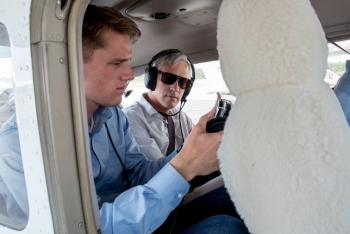SELC, others urge consideration of North Charleston cruise terminal option
Journalists for the city’s newspaper and a television station squeezed into a Cessna 172 with SELC's Blan Holman to get a birds-eye view of an alternative site for a proposed cruise terminal.
Members of Charleston’s historic downtown neighborhoods and business communities, represented by SELC, have repeatedly urged the U.S. Army Corps of Engineers to consider alternative sites for the proposed $35 million cruise terminal. The South Carolina State Ports Authority (SPA) wants the new terminal built in historic downtown Charleston. Because a new terminal would be built to host bigger ships—and even more than one ship at a time—putting the new terminal downtown would severely affect the adjacent neighborhoods.
Neighbors and business owners have voiced concerns to the Army Corps of Engineers about pollution, how the size of the hulking cruise ships would affect the character of historic sites, and the traffic that would overwhelm the already congested downtown area.
“The review process offers a chance and a duty to look at alternatives, not to just accept without question what the SPA proposed in 2010,” said Holman, Managing Attorney in SELC's Charleston office.
One option is to consider an underused state port facility up the river at Veterans Terminal.
Ports Authority documents obtained by SELC under open-records laws do not reveal any reason to exclude Veterans Terminal from consideration for the proposed cruise terminal. Veterans Terminal has sufficient berthing space, docking, and navigational depth for large cruise ships.

New perspectives
SELC’s Blan Holman prepares to take off with a local TV reporter to investigate alternatives to the cruise terminal proposed in Charleston’s historic downtown.
From the air, SELC helped local reporters see the benefits of locating a new facility at Veterans Terminal. Flying above the Cooper River, Holman showed the reporters how Veterans Terminal is closer to major interstates, the Charleston airport, and a variety of hotels. It is also close enough to run tourists on shuttles to the historic downtown. But it is far enough away that the increased traffic and congestion from passengers boarding the cruise ships would not affect Charleston’s traffic-choked downtown, which is protected as a National Historic District.
Plus, Holman told the reporters, it could revitalize a state facility in need of a boost.
“It seems like a win-win for everyone,” Holman said.
After the air tour, both the Post & Courier and WCBD News2, the city’s NBC affiliate, published stories on the push for the alternative site.
From the air, Holman said, it was easy to see why Veterans Terminal would make sense for both the cruise industry and the historic downtown.
“The documents we received from the SPA provided no compelling reason not to consider Veterans Terminal,” Holman said. “And from the air, it was just as plain to see what a good alternative that would be.”
